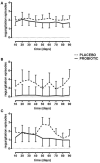Three-Month Feeding Integration With Bifidobacterium Strains Prevents Gastrointestinal Symptoms in Healthy Newborns
- PMID: 29888226
- PMCID: PMC5980983
- DOI: 10.3389/fnut.2018.00039
Three-Month Feeding Integration With Bifidobacterium Strains Prevents Gastrointestinal Symptoms in Healthy Newborns
Abstract
Infantile functional gastrointestinal disorders are common in the first months of life. Their pathogenesis remains unknown although evidences suggest multiple independent causes, including gut microbiota modifications. Feeding type, influencing the composition of intestinal microbiota, could play a significant role in the pathogenesis. Previous studies supported probiotic supplementation success against colics, however mainly Lactobacillus spp. were tested. The aim of this study was to evaluate the effectiveness against functional gastrointestinal disorders of a Bifidobacterium breve based probiotic formulation including in the study both breast-fed and bottle-fed subjects. Two hundred and sixty-eight newborns were enrolled within 15 days from birth. One hundred and fifty-five of them effectively entered the study and were randomized in probiotic and placebo group, receiving the formulation for 90 days. The probiotic formulation consists of a 1:1 mixture of 2 strains of B. breve prepared in an oily suspension and administered in a daily dosage of 5 drops containing 108 CFU of each strain. Absolute quantification of selected microbial groups in the faeces was performed using qPCR. Anthropometric data, daily diary minutes of crying, number of regurgitations, vomits and evacuations, and colour and consistency of stools were evaluated before and after treatment. The study confirmed the positive role of breast milk in influencing the counts of target microbial groups, in particular the bifidobacteria community. No adverse events upon probiotic administration were reported, suggesting the safety of the product in this regimen. B. breve counts increased significantly in all administered newborns (p < 0.02). The study demonstrates that a 3 months treatment with B. breve strains in healthy breast-fed newborns helps to prevent functional gastrointestinal disorders, in particular reducing 56% of daily vomit frequency (p < 0.03), decreasing 46.5% of daily evacuation over time (p < 0.03), and improving the stool consistency (type 6 at the Bristol Stool chart instead of type 5) in those at term (p < 0.0001). Moreover, a significant reduction (8.65 vs. 7.98 LogCFU/g of feces, p < 0.03) of B. fragilis in the bottle-fed group receiving the probiotic formulation was observed.
Keywords: Bifidobacterium breve; bottle-feeding; breastfeeding; functional gastrointestinal disorders; infant colic; microbiota; probiotic.
Figures



References
-
- Wessel MA, Cobb JC, Jackson EB, Harris GSJ, Detwiler AC. Paroxysmal fussing in infancy, sometimes called “colic.” Pediatrics (1954) 14:421–35. - PubMed
LinkOut - more resources
Full Text Sources
Other Literature Sources
Molecular Biology Databases
Miscellaneous

